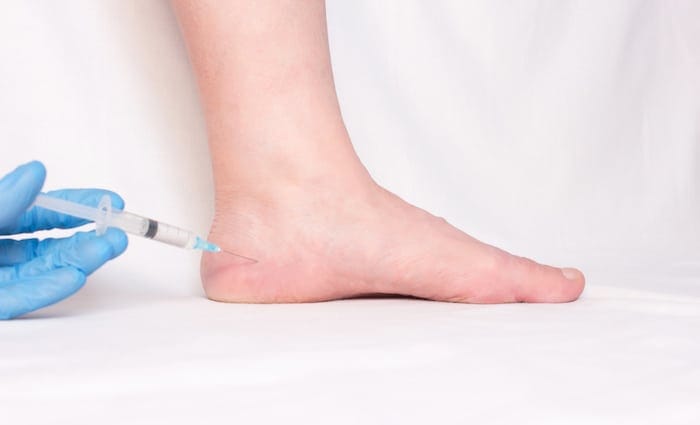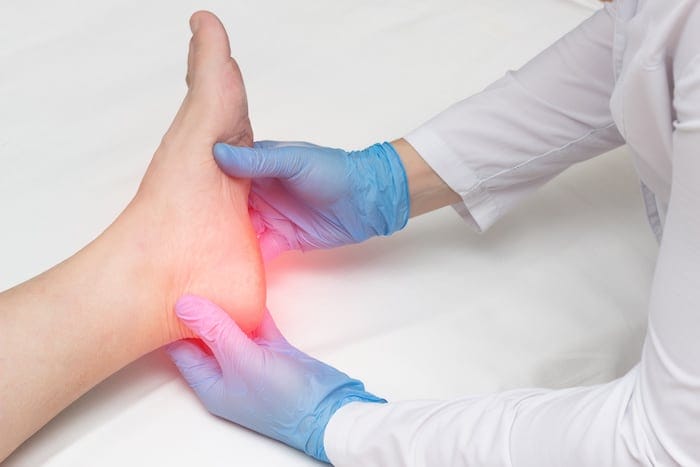The most common cause of heel pain is plantar fasciitis, which is the inflammation of a tendon in the heel. This condition occurs when the plantar fascia becomes inflamed due to excessive stretching, overuse, stress, and a variety of reasons.
Plantar Fasciitis does not happen overnight, it gradually builds up over weeks, months, or even years. Some individuals have been lucky enough to avoid getting this condition entirely. Still, most suffer from the symptoms on a fairly regular basis. If you’re suffering from this condition, read more below about the causes of this condition and how you can treat it.
What Is Plantar Fasciitis?
Plantar Fasciitis is caused by excessive stretching of the plantar fascia and extensor tendon that are found in the heel. Excessive activity that requires the use of the heel, like standing and running, can strain the foot and produce micro-tears in the fascia that results in symptoms such as pain, inflammation, and swelling in the heel.
Over time, chronic plantar fasciitis can develop due to the accumulation of micro-tears in the fascia. It is often painful due to the poor blood supply to the injured tissue. Being overweight, having high arches, or an abnormal foot structure can also increase the risk of getting plantar fasciitis.
You may also develop the condition due to a previous infection or fracture in the foot. In that case, the symptoms could be much worse, so you need to work closely with your doctor to determine the underlying cause.
To diagnose this condition, the doctor will have to examine your foot to evaluate the extent of the damage and determine the underlying cause of pain. They may also order some imaging tests to rule out other foot conditions like tumors, a broken bone, or a pinched nerve.
How Do Doctors Treat Plantar Fasciitis?
Your podiatrist will be able to help you determine which treatment is best for your condition. Depending on the severity of the injury, there are several ways to help fix heel pain that is caused by plantar fasciitis:

- Surgical Treatment
Surgical treatment for plantar fasciitis is performed only in the most severe cases. If you suspect that you have been injured and the symptoms do not seem to be caused by age, obesity, or other factors, your doctor may recommend surgery. Before surgery, the doctor will subject you to an MRI to detect bone deterioration, bone spurs, or growths and foot conditions that may be causing the symptoms.
- Foot Stretches And Exercises
Your doctor may recommend routine stretches to alleviate the symptoms. These stretches are designed to help the surrounding muscles of the foot to heal or reduce the pain you’re experiencing.
The recommended stretching exercises are those that involve gently pressing the plantar fascia into the ground while being stretched. This keeps the tissues stretched and ready for healing. Your doctor can show you how these exercises can be done, and they may also recommend special shoes or socks to protect your heel from further inflammation.
- Steroid Injections
Experts might also recommend steroid injections to alleviate the pain. Corticosteroids like iontophoresis are beneficial for patients with plantar fasciitis. Studies have revealed that steroid treatments have a success rate of at least 70 percent in healing this condition. However, a radiograph or ultrasound must be done before administering steroids to check if there are no tumors and other foot injuries that are the actual cause of the pain.
- Shoe Inserts
Many plantar fasciitis treatment options utilize custom-made inserts or custom-made orthotics that provide stability for the foot. The insole will provide cushioning for the heel and arch while your body keeps the balance.
Foam inserts help provide proper shock absorption. Some shoe inserts are used as a foot pillow for proper arch support. They are either placed inside or on top of the shoe to provide additional comfort and pain relief. The padding provides support to relieve pressure around the foot and ankle. If you are not sure which ones to choose you can go through this Protalus guide and find your perfect insole.
Conclusion
Heel pain can be bothersome because it restricts your movement and makes your day-to-day routine more difficult. If you’re suffering from plantar fasciitis, several treatment options are available to remove the cause of the pain or alleviate its symptoms.
For severe cases, surgery is the best option. Your doctor may also suggest stretching exercises that can help your heel recover faster. You can also check with your health care provider if you can get steroid injections and anti-pain medications that can help with the condition. You can also use specialized shoe inserts to alleviate the pain.
The Editorial Team at Healthcare Business Today is made up of skilled healthcare writers and experts, led by our managing editor, Daniel Casciato, who has over 25 years of experience in healthcare writing. Since 1998, we have produced compelling and informative content for numerous publications, establishing ourselves as a trusted resource for health and wellness information. We offer readers access to fresh health, medicine, science, and technology developments and the latest in patient news, emphasizing how these developments affect our lives.








